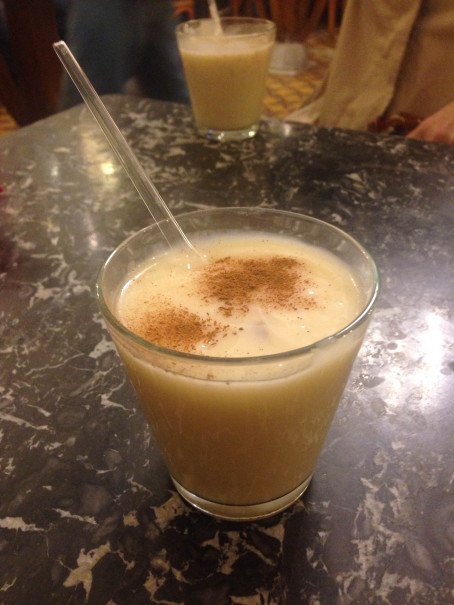
Try the Chicken Breast Pudding, It’s Delicious

Try the Chicken Breast Pudding, It’s Delicious
Boza in Istanbul
“This? Tavuk göğsü. Very good,” says the grinning grey-bearded man in a faded polo shirt behind the metallic counter of desserts.
“It looks delicious. Rice pudding?” I ask. It appears to have a similar consistency and color.
“Chicken.”
Turkey seems to specialize in delicious things to eat and drink that sound unappealing when they’re described. The dessert Tavuk göğsü, or chicken breast pudding, is a perfect example.
Another is boza.
It is the color of cream with a consistency that can be eaten with a spoon or drunk like a thick yogurt. It is made from fermented semolina millet, water, and sugar, and topped with a sprinkling of ground cinnamon and sometimes roasted chickpeas. At other times in history it has been topped with cloves, ginger, and nutmeg. My two friends were not particularly excited at the idea of fermented millet and gave a lukewarm response when I suggested we head over to Vefa Boza to sample some.
Vefa Boza was founded in 1876 in the Istanbul district of Vefa. The shop’s boza, with its thick consistency and tart flavor, became famous throughout the city, and it is the only one dating from that period still in business today. Only after visiting did I read that the shop features a mounted case displaying a glass from which Atatürk, the founder of the Turkish Republic, enjoyed a glass of boza. The company is run by the descendants of the founders. It is now a minor tourist attraction, featured in well-known guidebooks and foodie websites focused on Istanbul.
Variations of boza are found in most countries that border Turkey, and in Istanbul its history stretches back much further than this shop; a 17th century Ottoman traveler, Evliya Çelebi, reported widespread consumption of boza, with more than 300 boza shops in Istanbul alone. It was drunk by the Janissaries in the Ottoman army, tolerated because at 1 percent alcohol, it rarely caused drunkenness and was rich in carbohydrates and vitamins.
It’s easy to see—or rather, taste—why boza is popular. While fermented millet may not have sounded appealing to my friends when I first suggested it, it was a different story once they had tasted it. They had already ordered a second while I was savoring my first. For such a simple drink, it has an unlikely combination of delicate and contrasting flavors.
On first taste, it is sour and tart, very faint flavors of gooseberries or sour apples. This is heightened by the sweet cinnamon that has been sprinkled on top. Then the sugar in the boza fleetingly reveals itself the more it is consumed. Sometimes, the drink tastes mildly of soy milk, sometimes more like a rice pudding. It is the perfect blend of acidic and sweet. I can’t imagine how addictive the “tartar” version of boza produced in the 16th century tasted: apparently, it included opium.